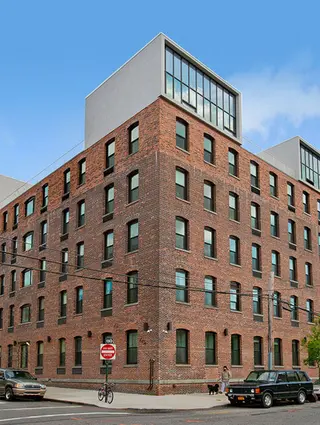 Carter Horsley
Carter HorsleyJan 25, 2013
Carter's Review
The Pencil Factory at 122 West Street in Greenpoint, Brooklyn is a residential condominium project that was expanded in 2012 from the original Eberhard Faber Pencil Factory complex.
Katan Development was the builder and Daniel Goldner was the architect. Mr. Goldner also designed the 8-story Modern 23 residential condominium project at 350 West 23rd Street. `
Several of the original factory buildings had red-brick masonry façades.
Mr. Goldner has expanded it significantly with beige and pale red panels and dark glass windows over a ground floor gray screen and he has tied together the composition with double-height “light boxes” on the roofline.
The development contains 93 condominium apartments.
Bottom Line
A wild mish-mash that mixes old red-brick masonry, with a checkerboard-pattern expansion with pale red and beige panels and dark windows over a light-gray mesh, all tied together with rectangular, double-height dormers just one long block from the waterfront.
Description
An article in the April 26, 2007 edition of The New York Sun by David Freedlander provided the following commentary about this project:
“Daniel Goldner Architects, which won an American Institute of Architects Design Award in 2004 for its Ironworkers Training facility in Long Island City, designed the new structure to blend in with the bricks of the surrounding neighborhood. The building will use multi-colored brick on its exterior to mimic the color variations of the 19th Century industrial buildings in the area. A series of cubic dormers will run along the top of the structure. ‘We wanted to reinterpret how today we might build a brick building,’ Mr. Goldner said. ‘It opens a dialogue across a period of time about new ways of construction and new ways of living.’ Mr. Goldner acknowledged that the pixilated skin of the building could appear unusual to neighborhood residents accustomed to flatter, foxier structures. ‘I think the asymmetrical quality of it really speaks to the way we live our lives now,’ he said. Our lives are not lined up in perfect little curbs. There is great power in abstraction.’ Mr. Goldner cited as his design influence the pared down minimalism of Donald Judd’s sculptures.”
The building’s very handsome lobby is punctuated with thin vertical lighting strips asymmetrically set in dark wood panels reminiscent of the unusual nighttime lighting effects of The Porter House rooftop addition at 366 West 15th Street in Chelsea in Manhattan.
The building has an entrance marquee.
One commenter on the Internet described the design of the complex’s new section as “funky.”
Amenities
The building has a doorman, an elevator, a gym, a bicycle room, on-site parking, tenant storage space, and a roof deck.
Apartments
Each apartment has GE stainless-steel kitchen appliances, and a washer and a dryer.
Apartment 5O is a one-bedroom unit with an entry foyer that leads to an open kitchen next to a 16-foot-long living/dining room.
Apartment 2Q is a two-bedroom unit with a long entry foyer that leads to a pass-through kitchen next to a 17-foot-long living/dining room.
Apartment 6G is a two-bedroom unit with an open kitchen with an island, a 12-foot-long dining area, a 20-foot-long living room and a 25-foot-long terrace.
History
The pencil factory opened in 1872 and closed in 1956.
The company was founded in 1861 by Eberhard Faber and was originally known as the A. W. Faber Company. According to the Landmarks Preservation Commission report on a proposed historic district around the compound, “following a disastrous fire at the Manhattan plant in 1872, Faber move the plant to Brooklyn.
“The company is credited with bringing German lead pencil-making techniques to the United States,” the report continued, adding that “most of the buildings in the historic district date from the mid-1880s to the 1910s and wee designed to complement the earlier structures, displaying elements of the German Renaissance Revival style, such as segmental lintels, carefully detailed brickwork, and corbels, as was pedimental parapets that display Faber’s star and diamond motif.”
“The earliest structures, located on West Street and extending the full block between Kent Street and Greenpoint Avenue, all date from the 1860s to the early 1880s, including the two south buildings that records suggest were acquired from a faience pottery works. These buildings are decorated with stone lintels that display the company’s logo, a feature that Faber trademarked for use on his pencils in 1861….
“The Faber family was known to have been engaged in making lead pencils in the village of Stein, Germany, near the city of Nuremburg as early as 1761 when the business was founded by Kasper Faber,…
In 1861, Faber was granted a trademark for the production of lead pencils and opened the American manufacturing branch of A.W. Faber, in a factory close to the East River, near 42nd Street, where the United Nations now stands…..There is no director evidence showing that the Fabers owned slaves at their Florida cedar plantation, but it is well known that the labor of mid-century sawmills in Florid was composed mainly of slaves and that a good deal of forest product was shipped to pencil factories in the north and in Europe..”

- Condo built in 1860
- Converted in 2012
- Located in Greenpoint
- 93 total apartments 93 total apartments
- 10 recent sales ($860K to $2.3M)
- Doorman
 6sqft delivers the latest on real estate, architecture, and design, straight from New York City.
6sqft delivers the latest on real estate, architecture, and design, straight from New York City.
